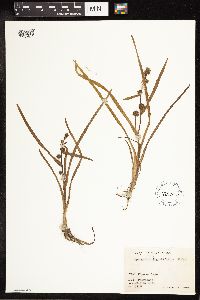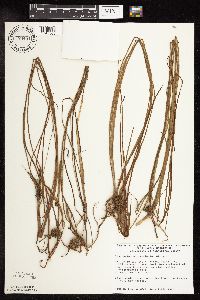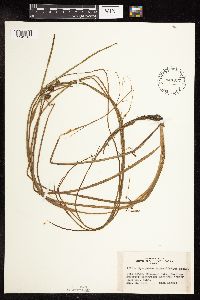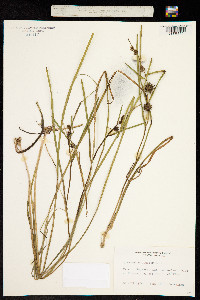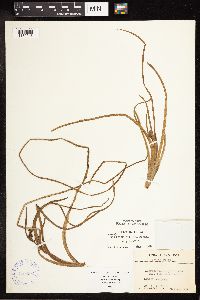Sparganium angustifolium
|
Sparganium angustifolium Michx.
 (redirected from: Sparganium chlorocarpum var. acaule (Beeby) Fern.) (redirected from: Sparganium chlorocarpum var. acaule (Beeby) Fern.) |
|
|
Family: Typhaceae
Narrow-Leaf Burr-Reed, more...narrowleaf bur-reed, narrowleaf burr reed, narrowleaf burreed
[Sparganium acaule (Beeby) Rydb., moreSparganium affine Schnizl., Sparganium borderi Focke, Sparganium boreale Laest. ex Beurl., Sparganium chlorocarpum Rydb., Sparganium chlorocarpum var. acaule (Beeby) Fern., Sparganium emersum subsp. emersum , Sparganium emersum var. angustifolium (Michx.) Taylor & MacBryde, Sparganium emersum var. multipedunculatum (Morong) Reveal, Sparganium fluitans , Sparganium multipedunculatum (Morong) Rydb., Sparganium simplex Muhl., Sparganium simplex var. angustifolium (Michx.) Torr.] |
Plants slender, to more than 2 m long; leaves and inflorescences usually floating. Leaves limp, unkeeled, flat to plano-convex, 0.2--0.8(--2.5) m 2--5(--10) mm. Inflorescences: rachis unbranched, flexuous, its fertile part usually erect at water surface; bracts ascending, lower bracts inflated near base; pistillate heads 2--5, at least some supra-axillary, not contiguous, sessile or most proximal peduncled (often prominently so in deeper water), 1--3 cm diam. in fruit; staminate heads (1--)2--4, contiguous and appearing as one elongate head, not contiguous with distalmost pistillate head. Flowers: tepals without subapical dark spot, erose-tipped, stigma 1, lance-ovate. Fruits reddish to brownish, dull, short-stipitate, ellipsoid to fusiform, not faceted, body constricted at equator, 3--7 mm, tapering to beak; beak straight, 1.5--2 mm; tepals attached at base, reaching about to equator. Seeds 1. 2n = 30. Flowering summer--fall (Jun--Oct southwestward, Jul--Aug northward). Acid, oligotrophic waters of lakes, ponds, ditches, and streams, usually in shallow waters but to 2.5 m deep; 0--4000 m; Greenland; St. Pierre and Miquelon; Alta., B.C., Man., N.B., Nfld. and Labr., N.W.T., N.S., Ont., P.E.I., Que., Sask., Yukon; Alaska, Ariz., Calif., Colo., Conn., Idaho, Maine, Mass., Mich., Minn., Mont., Nev., N.H., N.Mex., N.Y., Oreg., Utah, Vt., Wash., Wis., Wyo.; circumboreal. Sparganium angustifolium is sometimes abundant, its leaves then covering the surface. It is a relatively invariable species that forms fertile hybrids with S. emersum (C. D. K. Cook and M. S. Nicholls 1986), from which it is distinguished by its contiguous staminate heads and flat to plano-convex leaves. See the discussion under S. emersum.
STEMS: simple, 1.5 10 dm tall, erect but sometimes slender. LEAVES: (1.5 )2 8( 10) dm long, (5 )6 12( 15) mm wide, much longer than the stem, linear, flat, but slightly keeled to triangular keeled especially toward the somewhat expanded scarious margined base. INFLORESCENCE: simple, to 2 dm long; staminate heads 3 8, congested or confluent; pistillate heads 2 5, 1.8 3 cm in diam. when mature, the lowermost occasionally axillary or supra axillary, or pedunculate on a slender peduncle to 12 cm long. STAMINATE FLOWERS: perianth scales 2 4 mm long, oblanceolate, with a broadened erose apex; anthers 1 1.5 mm long, elliptic clavate. PISTILLATE FLOWERS: perianth scales (1 )1.5 2 mm long, oblanceolate, with a broadened erose apex; stigma linear, simple, (1 )1.5 2 mm long. FRUITS: 1 seeded, stipitate, the stipes 2.5 3.5( 6) mm long, the fruits 4 6 mm long, brown to greenish brown, fusiform, often constricted at the middle gradually to somewhat abruptly narrowing to a stylar beak, this 1.5 4( 5) mm long including the stigma. 2n = 30. NOTES: 2 vars., 1 in AZ; temperate regions. REFERENCES: Ricketson, Jon. 2001. Sparganiaceae. J. Ariz. - Nev. Acad. Sci. Volume 33(1). Perennial aquatic herb to 2 m or taller Leaves: usually floating, 0.2 - 0.8 m long, 2 - 5 mm wide, limp, not longitudinally folded, flat or with one face convex and the other flat. Inflorescence: usually floating, bracts ascending, lower bracts inflated near base, main axis unbranched and flexible, the fertile part usually erect at the water surface. Male flower heads are borne two to four but are tightly clustered and appear as a single elongate head that does not touch the uppermost female flower head. The stalkless or stalked (lowermost) female flower heads are not tightly clustered, borne two to five usually above the axil (supra-axillary). Flowers: tiny, with one narrow egg-shaped stigma and tepals lacking a dark spot near the unevenly cut tip. Fruit: a single-seeded achene-like drupe borne on a head 1 - 3 cm across, dull reddish to brownish, 3 - 7 mm long, elliptic to spindle-shaped, tapering to a straight beak 1.5 - 2 mm long, constricted at middle, the persistent tepals extending to the middle. Similar species: Sparganium eurycarpum is easily distinguished by having two stigmas in most female flowers and inverse pyramidal fruit. Sparganium americanum and Sparganium androcladum have erect, emersed leaves and inflorescences, and the inflorescences are branched. Sparganium natans usually has only one male flower head and a 0.5 - 1.5 mm fruit beak. Sparganium emersum may have erect, emersed or limp, floating leaves and inflorescences. Therefore, it is best distinguished by its 2 - 4.5 mm fruit beak, leaves that are longitudinally folded near the base, and male flower heads that are not clustered together. Flowering: July to August Habitat and ecology: Shallow water of lakes, ponds, ditches, and streams. Occurence in the Chicago region: native Etymology: Sparganium comes from the Greek word sparganion, a derivation of the word sparganon, meaning swaddling-band. This refers to the ribbon-like leaves of these plants. Angustifolium means narrow-leaved. Author: The Morton Arboretum Stem usually floating and elongate; lvs floating, rounded on the back, 2-6 mm wide; upper lvs and bracts conspicuously dilated at base; infl unbranched; pistillate heads 1-3, the lowest supra-axillary and usually peduncled, the others axillary, usually sessile, 1-2 cm thick when ripe; tep spatulate, erose, two-thirds as long as the frs; achenes brown, dull, the body 3-5 mm, fusiform, abruptly contracted to a 1 mm beak; staminate part of the infl 1-4 cm, the 1-6 heads close together; 2n=30. In deep or shallow water, occasionally on mud; Nf. to Alas., s. to N.J., Pa., Mich., and Calif. Gleason, Henry A. & Cronquist, Arthur J. 1991. Manual of vascular plants of northeastern United States and adjacent Canada. lxxv + 910 pp. ©The New York Botanical Garden. All rights reserved. Used by permission. Ordinarily erect, 0.5-6 dm; lvs usually much exceeding the stem, the lower distichously imbricate, erect or nearly so, flat or somewhat keeled, 2-7 mm wide, little or not dilated at base; bracts shorter, usually conspicuously erect or strongly ascending; infl unbranched; pistillate heads 1-4; usually crowded, sessile or the lowest short-peduncled, the lowest usually supra- axillary; tep spatulate, two-thirds as long as the achene; achene greenish-brown to brown, shining, fusiform, the body 4-6 mm, tapering to a conspicuous beak about as long, staminate part of the infl usually 4-10 cm, the heads few-several, not crowded; 2n=30. Swamps, muddy shores, and shallow water; Nf. and Que. to Ida., s. to W.Va., Ind., and Io. (S. acaule, a depauperate form) Gleason, Henry A. & Cronquist, Arthur J. 1991. Manual of vascular plants of northeastern United States and adjacent Canada. lxxv + 910 pp. ©The New York Botanical Garden. All rights reserved. Used by permission. |



































